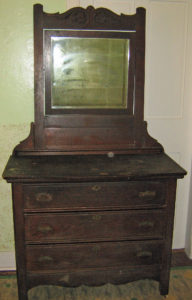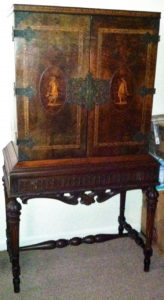by Lisa C. Cantwell
Dear Reader: This is a column to help you determine the history and value of your heirlooms, attic finds, flea market purchases or antique items. Please send a picture and description of your piece, such as how you acquired it and any details about its history to tomandlisa@wildblue.net I’ll research any item, whether it’s a piece of furniture or a painting, tool, doll, figurine, or an article of clothing. An approximate value will be determined to inform you if it’s a “Trinket or Treasure.” Please submit all pictures and questions by the preceding 15th the month for possible publication in the next monthly issue of The Catoctin Banner. All inquiries will be answered, however only those selected for publication will include approximate value assessments. Furthermore, not all submissions may be published in the Banner due to space considerations. Please include your name or initials and where you reside. Thank you and happy treasure hunting!
 “I recently got this dresser from my grandfather. It’s not in the greatest condition so I had planned on sanding it down and refinishing it, but when I pulled it away from the wall, I saw a stamp that is hard to see in the picture, but I believe says ‘patented dec 20th 1898.’ Now, I’m not sure if I should do anything to it for fear of taking away any value it may have. Any information you can give me would be great! Thank you!”
“I recently got this dresser from my grandfather. It’s not in the greatest condition so I had planned on sanding it down and refinishing it, but when I pulled it away from the wall, I saw a stamp that is hard to see in the picture, but I believe says ‘patented dec 20th 1898.’ Now, I’m not sure if I should do anything to it for fear of taking away any value it may have. Any information you can give me would be great! Thank you!”
— DLD, Emmitsburg
This is a TREASURE mostly because it was your grandfather’s, and it’s certainly too large to be a trinket! This dresser needs some TLC, so refinishing it would definitely improve the appearance and show off its walnut grain. I like the Formby’s method, but careful sanding and staining would work, also. Many are painting these timeworn, more common pieces, with a chalk paint that comes in an array of colors to choose from. I plan to paint an 1880s washstand I inherited that’s missing its doors, a cheery shade of mustard yellow. Painting isn’t always recommended, but on common late 19th century furniture such as this one, it’s the owner’s preference, as value is not an issue in the current antique market. Keep the mirror, spots and all, and the hardware, as is. It dates your antique and gives it that “shabby chic” character. Your dresser is common, but special to you. Why not give it your best effort and transform it into a usable, attractive antique!
 “I found this at the Emmitsburg Antique Mall about a year and a half ago. Inside the cabinet are adjustable shelves. The design on the doors is wood inlay. I know nothing about it and can’t find any marks anywhere. The hinges are loose and the back shows some water damage, but I absolutely love it. I paid $175 for it. It looks like the drawer and legs are hand-carved too. Hoping you can tell me something about it. Thanks.”
“I found this at the Emmitsburg Antique Mall about a year and a half ago. Inside the cabinet are adjustable shelves. The design on the doors is wood inlay. I know nothing about it and can’t find any marks anywhere. The hinges are loose and the back shows some water damage, but I absolutely love it. I paid $175 for it. It looks like the drawer and legs are hand-carved too. Hoping you can tell me something about it. Thanks.”
— Lisa D. Bell, Emmitsburg
Your TREASURE is a cabinet on stand. Although your piece is likely 19th century, these box-like cabinets were fashionable at the end of the 17th century. They were often used to store treasures and keepsakes for the bride-to-be. Some started as chests and were later perched on a stand. From the photo you provided, I’m guessing from the Italian-look of its base, that your cabinet may have been a separate piece at one time. Many of these cabinets were made of oak or walnut with other woods used within the marquetry such as rosewood, ebony, tulipwood, olivewood and barberry. Your cabinet on chest appears to be walnut from the photograph. The cabinet maker focused on the inlay or decorations, especially those that were made in Holland, which displayed ornate floral motifs. The oval pictures on the doors of your piece are Greek images. The beautiful bronze or brass hinges and latches are intricate and ornate as found on Asian chest on stands. This hodge-podge of styles, Greek Revival, Asian, Italian suggests late 19th century, as does the drop-style drawer pulls. It’s a lovely piece and worth investing some dollars into hinge repair and restoration of the back panel. Without realizing its provenance, it’s difficult to give you an exact date and value. However, you paid a fair price. When the antique furniture market is stronger and it’s been repaired, your chest could be worth as much as $400 to $500. The cabinets on chests that date to the 1700s and are French or Dutch in origin, bring as much as $4K and more. Asian antiquities, of course, are even more valuable. Thank you for sharing this beautiful antique!

